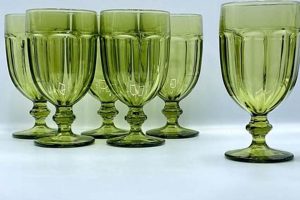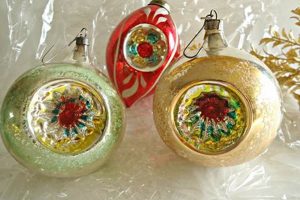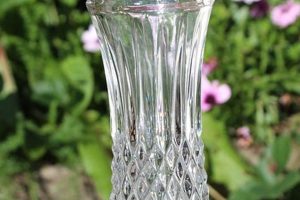These decorative objects, often crafted in clusters mimicking the fruit they represent, were popular ornaments in homes from the mid-20th century. Created using molded glass in various colors, they served primarily as aesthetic accents, reflecting light and adding visual interest to displays or tablescapes. Examples range from single, small bunches to elaborate arrangements incorporating leaves and stems, often found adorning centerpieces or curio cabinets.
The appeal of these items lies in their nostalgic charm and connection to a bygone era of interior design. Their durability and relatively low cost made them accessible decorative pieces for a wide range of households. Furthermore, they represent a specific aesthetic that resonates with collectors interested in vintage and mid-century modern design. The enduring popularity stems from their ability to evoke feelings of warmth and familiarity, connecting individuals to memories and traditions of the past.
This article will delve into the methods of identifying authentic examples, discussing the common manufacturers and styles, and providing guidance on the proper care and preservation of these delicate and historically significant collectibles. Further, it will explore the current market value and factors that influence collectibility, assisting both novice and experienced collectors in appreciating and acquiring these decorative treasures.
Tips on Collecting Vintage Glass Grapes
Careful consideration is essential when acquiring these delicate decorative items. Understanding the nuances of production and identifying potential flaws can significantly impact collecting success.
Tip 1: Authenticate Markings: Examine each piece for manufacturer’s marks. Though not always present, identifiable marks from companies such as Fenton or Westmoreland increase value and provide provenance.
Tip 2: Inspect for Damage: Closely scrutinize each grape and leaf for chips, cracks, or repairs. Damage significantly detracts from both aesthetic appeal and monetary value. Use a magnifying glass for detailed inspection.
Tip 3: Assess Color Consistency: Variations in color within a single bunch should be minimal. Inconsistent coloration may indicate repairs or variations in glass batch, potentially lowering value.
Tip 4: Evaluate Construction Quality: Examine the stem and wiring holding the grapes together. Sturdy construction and original wiring indicate higher quality and better preservation.
Tip 5: Research Rarity of Color: Less common colors, such as cranberry or black, tend to be more valuable. Researching color variations before purchase can inform buying decisions and identify potential treasures.
Tip 6: Consider Overall Condition: Dust and grime can obscure flaws. Gently clean the piece (if possible, without damaging) to get a clear view of the glass and construction before committing to a purchase.
Tip 7: Compare Prices Across Sources: Review prices on multiple platforms (antique stores, online auctions) to establish a fair market value. Be wary of prices that are significantly higher or lower than the average.
By adhering to these guidelines, collectors can enhance their chances of acquiring genuine, well-preserved pieces, thereby maximizing their enjoyment and potential investment.
The following sections will further explore preservation techniques and strategies for building a comprehensive collection.
1. Manufacturing Techniques
The methods employed in the creation of these decorative items profoundly influence their aesthetic qualities, durability, and ultimately, their value to collectors. Examination of these techniques provides insight into the origin and authenticity of the object.
- Pressed Glass Molding
Many examples were created using pressed glass techniques. Molten glass is forced into a mold, allowing for mass production of uniform shapes. This method often results in visible mold lines and a less refined finish. The repetitive nature of pressed glass allowed for affordable production costs, contributing to the widespread popularity of these items.
- Hand-Blown Glass
More elaborate or high-end items might utilize hand-blown glass. A glassblower shapes the molten glass using various tools and techniques. Hand-blown examples often exhibit unique characteristics and subtle variations, reflecting the artisan’s skill. This technique allows for greater detail and more complex forms but is more labor-intensive and costly.
- Lampworking
Lampworking involves using a torch to melt glass rods and shape them into intricate designs. This technique allows for the creation of highly detailed individual grapes and leaves, often seen in more delicate or artistic pieces. Lampworked examples showcase finer details and greater complexity compared to pressed glass but are often more fragile.
- Assembly Methods
Regardless of the glass forming technique, the assembly of the grapes into clusters involved specific methods. Individual glass components were often wired or glued together to create a cohesive bunch. The type of wire or adhesive used, along with the overall structural integrity, can indicate the age and quality of the piece. Original wiring and secure assembly are often indicative of well-preserved or higher-quality examples.
The diversity in manufacturing processes dictates the appearance and value of these decorative pieces. Identifying the technique employed is vital for proper authentication, valuation, and preservation. Recognizing distinctions between mass-produced pressed glass and handcrafted lampworked items, for example, allows for informed appreciation and collecting decisions.
2. Color Variations
The spectrum of colors observed in these decorative objects represents a significant aspect of their history and value. The deliberate selection and manipulation of glass colorants during the manufacturing process directly influenced the aesthetic appeal and market desirability of these items. Early formulations often relied on readily available minerals and compounds, resulting in shades of green, amber, and clear glass. The introduction of new technologies and chemical additives expanded the palette to include vibrant hues like cranberry, cobalt blue, and uranium green. Variations in color result from the addition of different metallic oxides to the molten glass. For instance, the presence of uranium oxide creates a distinctive green that fluoresces under ultraviolet light. This coloration, while initially popular, became less common due to regulations regarding uranium usage.
Color variations serve as important indicators of age and origin. Certain color combinations or specific shades may be associated with particular manufacturers or production periods. For example, Fenton Glass Company’s ‘Vaseline’ glass, characterized by its yellow-green hue, is a recognizable and sought-after color variant. Likewise, limited-edition colors or experimental batches often command higher prices among collectors due to their rarity. Imperfections in color, such as streaking or inconsistent tones, can also provide clues about the glassmaking techniques employed and the level of quality control during production. The color consistency serves as a barometer to assess authentic vintage versus contemporary imitations.
Understanding the significance of color allows collectors to make informed purchasing decisions and appreciate the artistry involved in glass production. A thorough examination of color, combined with knowledge of manufacturing techniques and historical context, is essential for identifying, valuing, and preserving these tangible artifacts of decorative history. The deliberate use of color transformed ordinary glass into coveted collectibles, demonstrating the powerful impact of artistic choices on the enduring legacy of these objects.
3. Era of Production
The period in which these glass clusters were produced significantly influences their style, materials, and consequently, their value. The mid-20th century, particularly the 1950s through the 1970s, represents the peak era for their manufacture and prevalence. This period coincided with increased affordability of mass-produced glass items and a burgeoning interest in home dcor. Prior to this, more elaborate examples might have been crafted by skilled artisans, reflecting the higher cost of materials and labor. After this period, changing tastes and the rise of alternative materials led to a decline in popularity, making examples from the mid-century more sought after by collectors. Identifying the manufacturing era helps to ascertain the techniques used and the likely origin of the piece.
For instance, Art Deco-inspired clusters from the 1930s, while less common, often exhibit streamlined designs and utilize different types of glass compared to their mid-century counterparts. Similarly, examples produced in the 1980s might incorporate acrylic or plastic components alongside glass, reflecting the shift towards cheaper alternatives. Understanding the characteristics associated with each era allows collectors to distinguish between genuine vintage pieces and later reproductions or adaptations. Furthermore, the era of production impacts the condition of the item, as older examples may exhibit signs of wear and tear consistent with age, which can affect their value.
Therefore, the era of production is a critical component in understanding and appreciating these decorative objects. Recognizing the stylistic trends, manufacturing techniques, and materials associated with different periods enables accurate identification, valuation, and ultimately, informed collecting practices. Failing to consider the era of production can lead to misidentification and potentially overpaying for a non-vintage or reproduction item. Its influences the item’s value, rarity, and overall appeal in the collector’s market.
4. Condition and Damage
The state of preservation significantly dictates the desirability and monetary value of these vintage collectibles. Damage, ranging from minor chips to extensive fractures, directly diminishes aesthetic appeal and historical integrity. Environmental factors, improper handling, and inherent fragility of the glass material contribute to the deterioration observed in many examples. Exposure to sunlight can cause fading or discoloration, while temperature fluctuations and physical impacts lead to cracks and breaks. The presence of such imperfections serves as a critical consideration for both seasoned collectors and casual enthusiasts seeking to acquire these artifacts.
Careful inspection for damage is paramount before any purchase. Common flaws include chips along the edges of individual grapes or leaves, cracks in the connecting stems, and evidence of repairs or restorations. While minor imperfections may be acceptable in exceptionally rare pieces, significant damage invariably reduces value. Examples with substantial cracks or missing components are typically considered less desirable. The presence of yellowing or cloudiness in the glass, often due to age or improper storage, can also detract from aesthetic appeal. Identifying these issues requires close scrutiny under adequate lighting, utilizing magnification to reveal subtle imperfections that may not be immediately apparent.
Ultimately, the condition plays a pivotal role in determining the authenticity and collectibility of vintage glass grapes. A well-preserved example not only embodies the artistic vision of its creators but also represents a tangible connection to the past. Conversely, damaged pieces, while potentially retaining historical significance, often serve as reminders of the passage of time and the challenges inherent in preserving delicate artifacts. Recognizing and assessing the nature and extent of damage is essential for making informed purchasing decisions and ensuring the long-term preservation of these nostalgic decorative items.
5. Rarity and Markings
The convergence of scarcity and identifiable maker’s marks significantly influences the desirability and valuation of vintage glass grapes. The presence or absence of such markings, coupled with the relative scarcity of specific designs or colors, serves as a primary determinant in the collector’s market.
- Signatures and Maker’s Marks
Identifiable marks from manufacturers, such as Fenton, Westmoreland, or Imperial Glass, provide provenance and enhance the value. These marks, typically found on the underside of leaves or stems, authenticate the origin of the piece. A piece with a documented maker’s mark holds increased significance compared to unmarked examples, as it provides a tangible link to the item’s history and production methods.
- Limited Production Runs
Certain color variations or designs were produced in limited quantities, contributing to their scarcity and desirability. Examples include uranium glass, cranberry glass, or those featuring unique decorative elements. The limited availability of these variations elevates their status among collectors, driving up market prices. Awareness of historical production data assists in identifying and valuing these rare pieces.
- Design Patents and Prototypes
Documented design patents associated with particular grape cluster designs add a layer of historical significance and value. Prototypes or experimental pieces, often identifiable through unique design elements or unconventional color combinations, are exceedingly rare and command premium prices. Research into patent records and manufacturer archives can uncover information regarding these exceptional items.
- Geographic Origin and Distribution
Clusters produced in specific geographic regions or distributed through limited retail channels often possess enhanced rarity. European examples, particularly those from Bohemia or Italy, may exhibit distinctive characteristics and limited availability in the North American market. Knowledge of historical distribution networks informs the assessment of regional variations and their corresponding value.
The interplay between documented markings and demonstrable scarcity defines the upper echelons of the vintage glass grape collecting sphere. Successful collectors leverage a combination of historical research, connoisseurship, and market awareness to identify and acquire these prized artifacts, contributing to the preservation of a tangible piece of decorative arts history. The ability to discern genuine markings and assess relative rarity separates the casual enthusiast from the serious collector.
Frequently Asked Questions
The following section addresses common inquiries regarding the identification, valuation, and preservation of vintage glass grape clusters, providing authoritative insights for collectors and enthusiasts.
Question 1: How can genuine vintage examples be distinguished from modern reproductions?
Authentic vintage examples often exhibit subtle imperfections inherent in older glass manufacturing processes, such as minute bubbles or slight variations in color consistency. Modern reproductions typically display a higher degree of uniformity and may lack the patina associated with age. Examining the quality of construction and the presence of maker’s marks aids in differentiating between the two.
Question 2: What factors contribute to the monetary value of these collectible items?
Several elements influence valuation. Rarity, as determined by color, design, or limited production runs, significantly impacts price. The presence of identifiable maker’s marks and the overall condition of the piece are also critical considerations. Market demand and historical significance further contribute to the overall value assessment.
Question 3: What are the appropriate methods for cleaning and preserving glass grape clusters?
Gentle cleaning with a soft brush or lint-free cloth is recommended. Avoid harsh chemicals or abrasive cleaners, as these can damage the glass surface. Proper storage in a cool, dry environment away from direct sunlight prevents fading and deterioration. Supporting fragile clusters with acid-free tissue paper minimizes the risk of breakage.
Question 4: How should potential damage or repairs be assessed before purchasing?
Close inspection under bright light is essential. Examine each grape and leaf for chips, cracks, or repairs. Scrutinize the connecting stems for signs of stress or instability. Repaired areas may exhibit discoloration or inconsistencies in the glass surface. A thorough assessment of damage informs a realistic valuation and prevents costly surprises.
Question 5: Which manufacturers are most associated with high-quality vintage glass grape production?
Several companies were prominent in producing these items. Notable examples include Fenton Art Glass Company, Westmoreland Glass Company, and Imperial Glass Corporation. Pieces bearing identifiable marks from these manufacturers are often considered more valuable due to their documented history and reputation for quality craftsmanship.
Question 6: Are there specific color variations that are particularly sought after by collectors?
Yes, certain color variations command higher prices. Uranium glass, characterized by its distinctive green fluorescence under ultraviolet light, is highly desirable. Cranberry glass, cobalt blue glass, and other rare or limited-edition colors also attract significant interest from collectors. The scarcity and visual appeal of these color variants contribute to their enhanced value.
In summary, a comprehensive understanding of manufacturing processes, historical context, and market trends is essential for navigating the complexities of collecting vintage glass grape clusters. Diligent research and careful evaluation contribute to informed purchasing decisions and the long-term preservation of these decorative artifacts.
The following section transitions to practical tips for building a comprehensive and valuable collection.
In Conclusion
This exploration has elucidated the multifaceted nature of vintage glass grapes, underscoring their significance as collectible artifacts. Key aspects, including manufacturing techniques, color variations, era of production, condition, and rarity, have been examined to provide a framework for informed appraisal and appreciation. The enduring appeal stems from their connection to a bygone era of decorative arts and the tangible link they provide to historical manufacturing processes.
Continued interest in these objects ensures their preservation for future generations. Further research and meticulous collecting practices will contribute to a deeper understanding of their cultural and historical context. The meticulous study of “vintage glass grapes” not only enriches the collector’s experience but also serves as a valuable contribution to the broader field of decorative arts preservation and scholarship.







